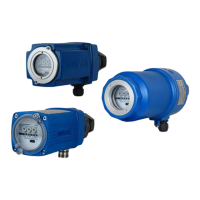6 | Configuration and function
D-LX 201/721
43
With NOx-reduction measures for the combustion, such as exhaust gas recirculation
or systems with combi burners for gas and oil, the IR flame sensors in particular have
proved themselves suitable for flame monitoring with a spectral sensitivity of up to
1800 nm.
In practice, static emitters such as glowing boiler components are modulated by
combustion air currents or flue gas vapours, and act as background radiation with
dynamic radiation shares. If this radiation is within the capture range, i.e. in the IR
range and the usual flicker frequency range (approx. 10 to 200 Hz) for a flame, an
output signal is generated by the flame monitor according to the intensity and the
dynamic of the received radiation. The flame monitor's switching threshold must not be
exceeded as a result of this background radiation, and must never lead to a flame ON
notification (see section 8.2 Setting the threshold for the intensity [}73]).
6.1.2 Ultraviolet flame sensor
A flame's UV radiation zone is generally considerably smaller than its IR zone. Fix-
tures and boiler walls also do not emit any dynamic UV radiation. UV flame monitors
are therefore very selective, i.e. resistant to background radiation [}115].
In D−LX xxx UA, a photodiode with a spectral sensitivity of λ= 190 to 520 nm is used.
The integrated flame sensor thereby records the dynamic blue to transparent radiation
range, e.g. of gas, oil and coal flames, without suffering any major signal failures as a
result of water vapour, recirculation gas or similar UV-absorbing gases.
In D−LX xxx UAF, the D−LX xxx UA photodiode with optical filter is used. This filtering
brings about a limited spectral range of λ= 280 to 410 nm, which gives better results
with very intensive UV radiation or with higher selectivity requirements.
The filter is impermeable in the visible spectral range, and therefore appears black to
the human eye. The photodiode is visible through the flame monitor lens.
6.1.3 Self-monitoring
The compact flame monitor with integrated flame sensor is a failsafe flame monitor
(i.e. the flame monitor moves to a safe state in the event of a fault) with a self-monitor-
ing function. Once the mains power supply has been switched on, the flame monitor
device carries out a self test, which is constantly repeated during subsequent continu-
ous operation.
In continuous operation, every fault within a component leads to an error shutdown
whenever safety-relevant functions are affected. The flame monitor features a dual-
channel microcontroller system (channel 1 and channel 2), which controls all functions
and self tests, and monitors all safety-relevant time sequences. The input and output
states are checked by the two microcontrollers independently from one another and
are then compared, and operation is only continued if the states match.
The consistent dual-channel configuration (see Fig.6.3 in section 6.1 Functional de-
scription [}41]) makes it possible to avoid regular interruption of the photocurrent
(shutters) and to forego mechanical wear parts.

